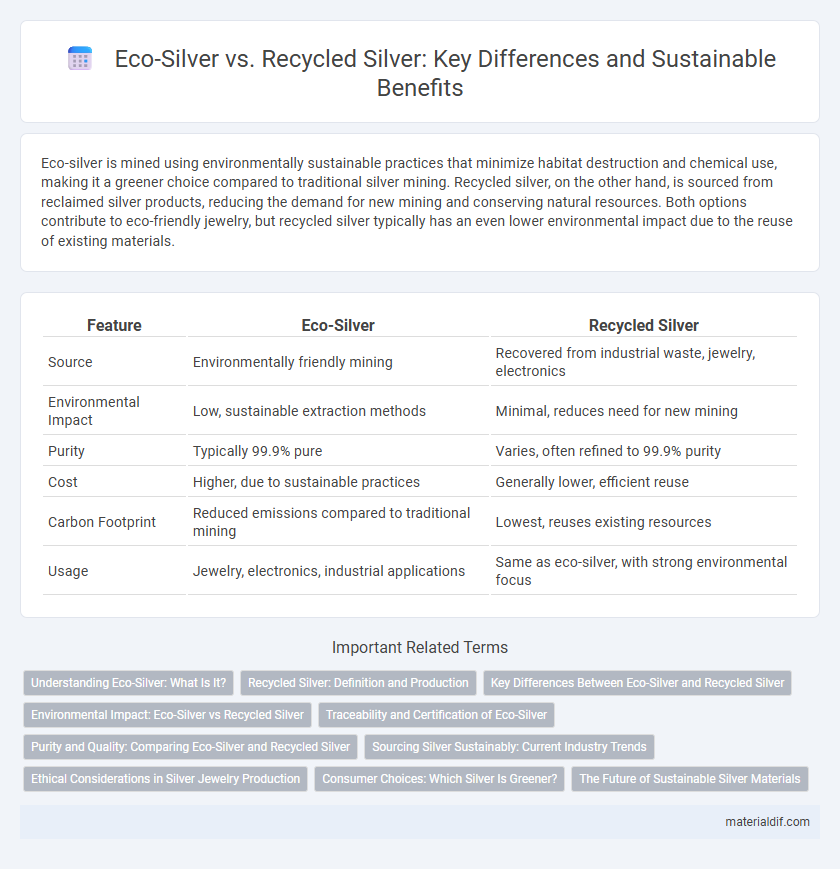Eco-silver is mined using environmentally sustainable practices that minimize habitat destruction and chemical use, making it a greener choice compared to traditional silver mining. Recycled silver, on the other hand, is sourced from reclaimed silver products, reducing the demand for new mining and conserving natural resources. Both options contribute to eco-friendly jewelry, but recycled silver typically has an even lower environmental impact due to the reuse of existing materials.
Table of Comparison
| Feature | Eco-Silver | Recycled Silver |
|---|---|---|
| Source | Environmentally friendly mining | Recovered from industrial waste, jewelry, electronics |
| Environmental Impact | Low, sustainable extraction methods | Minimal, reduces need for new mining |
| Purity | Typically 99.9% pure | Varies, often refined to 99.9% purity |
| Cost | Higher, due to sustainable practices | Generally lower, efficient reuse |
| Carbon Footprint | Reduced emissions compared to traditional mining | Lowest, reuses existing resources |
| Usage | Jewelry, electronics, industrial applications | Same as eco-silver, with strong environmental focus |
Understanding Eco-Silver: What Is It?
Eco-silver refers to silver that is mined and processed with environmentally responsible practices, minimizing ecological impact and reducing carbon emissions. This contrasts with recycled silver, which involves melting down existing silver objects to reuse the metal, thereby conserving resources but not addressing mining-related environmental concerns. Understanding eco-silver involves recognizing its commitment to sustainable mining techniques, ethical sourcing, and reducing habitat destruction compared to traditional silver extraction.
Recycled Silver: Definition and Production
Recycled silver is extracted from existing silver products, scrap, and industrial by-products, reducing the need for new mining activities and conserving natural resources. The production process involves melting down and refining discarded silver items to remove impurities, ensuring high purity and quality equivalent to newly mined silver. This method significantly lowers environmental impact by minimizing energy consumption and reducing waste compared to traditional silver extraction.
Key Differences Between Eco-Silver and Recycled Silver
Eco-silver is produced using environmentally friendly methods that minimize energy consumption and reduce chemical waste, emphasizing sustainable mining and processing practices. Recycled silver, on the other hand, is derived from repurposing existing silver materials, significantly lowering the demand for new mining and conserving natural resources. The key difference lies in eco-silver's focus on green extraction techniques, while recycled silver prioritizes the reuse of silver through collection and refining processes.
Environmental Impact: Eco-Silver vs Recycled Silver
Eco-silver is produced through sustainable mining methods that minimize habitat disruption and reduce carbon emissions, ensuring a lower environmental footprint compared to traditional silver extraction. Recycled silver, on the other hand, utilizes existing silver materials, significantly decreasing the demand for new mining and conserving natural resources while reducing waste sent to landfills. Both approaches contribute to environmental preservation but recycling silver offers the highest reduction in energy consumption and greenhouse gas emissions by reprocessing metal without the need for extensive raw material extraction.
Traceability and Certification of Eco-Silver
Eco-silver ensures superior traceability through strict sourcing from responsible mines certified by organizations like the Responsible Jewellery Council (RJC) and the Alliance for Responsible Mining (ARM). Unlike recycled silver, which often lacks full supply chain transparency, eco-silver's certification guarantees ethical mining practices and environmental sustainability. This rigorous certification process helps brands and consumers verify the origin and impact of their silver, reinforcing trust and accountability in the marketplace.
Purity and Quality: Comparing Eco-Silver and Recycled Silver
Eco-silver typically offers higher purity levels, often exceeding 99.9%, due to stringent sourcing and refining processes focused on minimizing environmental impact without compromising quality. Recycled silver quality varies depending on the original product and refining methods, which can introduce impurities and require extensive purification to reach comparable purity. The meticulous refinement in eco-silver production ensures consistent alloy integrity and superior finish, making it a preferred choice for applications demanding high-quality silver.
Sourcing Silver Sustainably: Current Industry Trends
Eco-silver and recycled silver represent leading trends in sustainable sourcing within the silver industry, with eco-silver derived from environmentally responsible mining practices that minimize ecological impact. Recycled silver, recovered from pre-existing silver products, significantly reduces the need for virgin ore extraction and lowers overall carbon emissions. Current industry shifts emphasize transparency, traceability, and certifications like Fairmined to support ethical and sustainable silver procurement.
Ethical Considerations in Silver Jewelry Production
Eco-silver refers to silver sourced through environmentally sustainable mining practices that minimize ecological damage and support fair labor conditions, whereas recycled silver is reclaimed from existing silver products, reducing the need for new mining and lowering carbon footprints. Ethical considerations in silver jewelry production emphasize transparency in sourcing, reduction of environmental impact, and the promotion of fair wages and safe working environments for miners and artisans. Choosing eco-silver or recycled silver supports responsible consumption by prioritizing sustainability and ethical labor practices in the precious metals industry.
Consumer Choices: Which Silver Is Greener?
Eco-silver, sourced from environmentally responsible mining practices, minimizes habitat destruction and reduces carbon emissions compared to conventional methods. Recycled silver, derived from repurposing existing silver products, significantly lowers energy consumption and reduces mining waste. Consumers seeking greener options often prefer recycled silver for its circular economy benefits, while eco-silver appeals to those supporting sustainable mining initiatives.
The Future of Sustainable Silver Materials
Eco-silver, derived from processes minimizing environmental impact, offers a promising alternative to traditional silver with reduced carbon footprints and responsible mining practices. Recycled silver, sourced from reclaimed metals, significantly lowers demand for virgin silver, conserving natural resources and reducing waste. Both materials play crucial roles in advancing the future of sustainable silver, essential for circular economy models and eco-conscious industries.
Eco-silver vs Recycled silver Infographic

 materialdif.com
materialdif.com